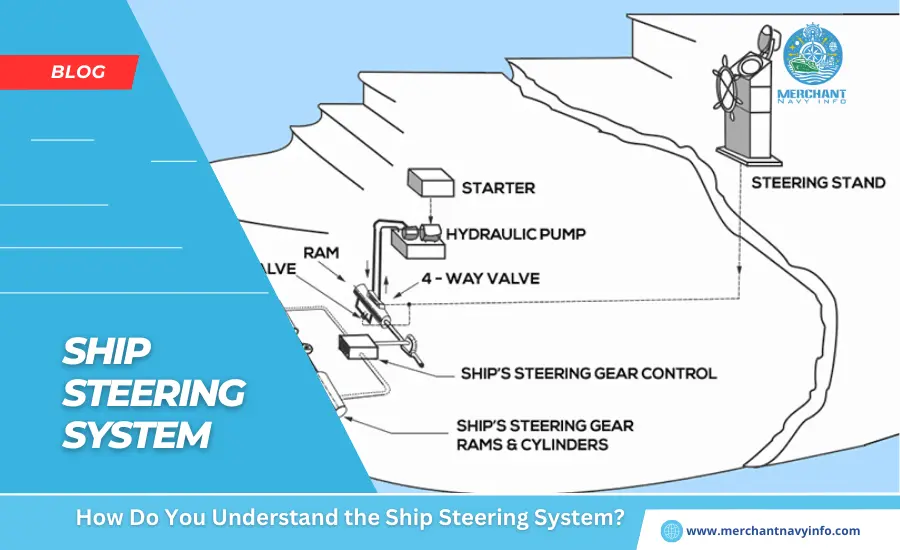
We all know that we use the rudder to turn the ship when needed. The rudder is the main system for all movement and control on the ship. However, we must not forget that the entire rudder movement depends on another central system called the steering gear.
The steering gear integrated into the rudder system defines the complete “turning mechanism” required for each individual vessel, regardless of size, type and operation. Rudder systems have been an integral part of ship machinery since the invention of the very earliest manually operated ships.
Marine Steering Gear Systems
The performance efficiency of a steering system depends on several key aspects. These basic requirements for all steering gear are based on classification society regulations. They can be simply described as follows:
- According to standard requirements, a rowing machine must be able to steer a vessel from 35 degrees port to 35 degrees starboard or vice versa, and also the vessel must be able to move forward at a constant frontal speed. It doesn’t have to be. Maximum continuous rated shaft speed.
- If one of the engines does not operate, the rudder must be able to rotate from 15 degrees port to 15 degrees starboard (or vice versa) within 15 seconds. For one minute from port to 15 degrees starboard (or vice versa), the vessel will travel at half (whichever is greater) of its maximum rated speed of also 7 knots at the summer load line.
- The main propulsion unit and control system should be duplicated so that if one fails, the other can be easily replaced as a spare
- Emergency power supply: The steering system has an additional unit (hydraulic) must be provided. (pumps, etc.) connected to the emergency power source of the emergency generator, sailing at maximum operating speed or 7 knots, whichever is greater, and also capable of steering her 15 degrees to port or starboard within 60 seconds. Must be.
Types of Ship Rudder Systems
As ships became larger and faster, modern systems reduced human effort. There are basically two types of commonly used steering gear systems:
- Hydraulic
- Electro-hydraulic type.
Although the system has undergone some major developments, the basic operating physics The science is the same. Similar to a car, the primary control for steering a ship is from the helm, and all control of the vehicle’s “manoeuvrability” rests with the driver’s steering wheel. The “control force” for turning is transmitted from the steering wheel to the steering gear.
Rudder System
A rudder system generates a certain amount of torsional force that is transmitted to the rudder shaft, causing the rudder to rotate. Intermediate control systems in modern ships are diverse, with each small component having its own function. I will refrain from discussing each of these components in detail. The rudder system consists of:
- Rudder actuator
- Power unit
- Other auxiliary equipment required to apply torque and apply the rudder
- Hydraulic pumps and valves
In hydraulic and electro-hydraulic systems, hydraulic pumps are mainly (electro-hydraulic systems), or sometimes purely mechanically driven (hydraulic systems).
Hydraulic systems
However, today, modern electro-hydraulic systems have become mainstream on ships. These hydraulic pumps play a critical role in generating the pressure necessary to create the movement of the rudder gear that can induce the required torque in the rudder system.
There are basically two main types of these pumps.
- Radial piston type (Heleshaw)
- Axial piston type (swashplate)
The actuator mediates the coordination between the hydraulic pressure and the hydraulic pressure produced by the pump (electrically driven, of course). By converting them, the rudder shaft converts mechanical forces that produce rudder torque. Currently, actuators are mainly driven electrically by power units.
Ram Steering Gear System
The Ram steering gear is one of the most commonly used steering gear designs and is very expensive to manufacture. The basic principle is the same as that of hydraulically driven motors and elevators. Four hydraulic cylinders are mounted on two arms on either side of the actuation disc. These cylinders are directly connected to an electric hydraulic pump that generates hydraulic pressure through piping.
This hydraulic field present in the pump causes the movement of a hydraulic cylinder, which corresponds to an actuator acting on the rudder shaft. As you know, the rudder stock is an integral part of a ship’s entire steering system and determines the exact behaviour of the rudder’s response. The direction of rotation of the rudder is determined by the hydraulic pump’s operation. The physics behind its functionality can be explained better in the following diagram.
Similarly, counterclockwise does the opposite. The pressure end of the pump is connected to cylinders B and D, and the suction end of the pump is connected to A and C. This reverse pressure flow from the hydraulic pump is achieved using a control valve operated from the wheelhouse. The steering gear arrangement of the tappet design produces fairly high torque for a given power output. Hydraulic pressure varies between 100 bar and 175 bar depending on rudder size and required torque.
Rotary Vane Steering Gear
The Rotary Vane Steering Gear has a fixed housing in which two vanes rotate. The housing, together with the wings, forms four chambers. The operation is similar to the ram type, but there are some differences. When chambers A and C are pressurized, the blades rotate counterclockwise. A and C are connected to the pressure side of the pump, and chambers B and D are connected to the suction side of the pump.
If clockwise rotation is required, B and D are connected to the discharge side of the pump, and A and C are connected to the suction side of the pump. Similar to the above, this is also controlled by a special control valve. Therefore, different pressures in the chambers create rotational moments in the blades.










